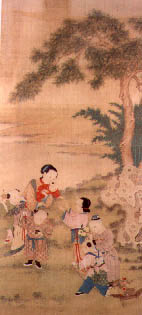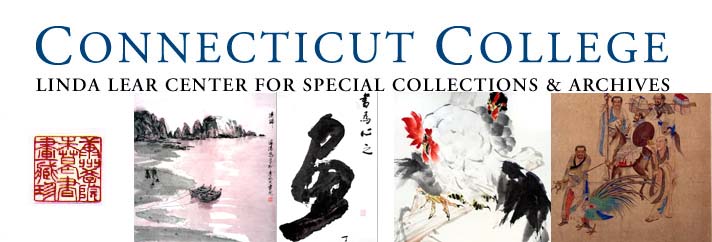Human Figure Paintings
Chiu Chu (mid-16th Century)
Two Mothers and Children
Chinese Ink on Rice Paper, framed, 41 3/4 x 19 1/4 in., (106 x 49 cm.)
 In Chinese art history books, women artist are recorded in small number. With few exceptions, references are footnotes in the family histories of artists. Nevertheless, extant paintings by women painters show that they were educated, talented individuals. Some came from families of the gentry. Some came from professional artist households. Some were courtesans. These classifications imply that women artists create works of art for personal pleasure, to augmenting family income or to entertain their patrons.
In Chinese art history books, women artist are recorded in small number. With few exceptions, references are footnotes in the family histories of artists. Nevertheless, extant paintings by women painters show that they were educated, talented individuals. Some came from families of the gentry. Some came from professional artist households. Some were courtesans. These classifications imply that women artists create works of art for personal pleasure, to augmenting family income or to entertain their patrons.
Chiu Chu belonged to the second category. She was the elder daughter of the famous professional artist Chiu Ying of Ming dynasty (1368-1644). As in her father's case, little information was recorded due to a snobbish way of treating professional artists in the old days.
What we know indicates that Chiu Chu was married. She preferred to live alone in order to paint, burn incense, practice calligraphy and play music. She learned painting entirely from her father in both painting subjects and stylistic elements. While her father concentrated on painting ancient legends and popular stories, Chiu Chu worked on flowers and landscapes, but her specialties were figure paintings of women and children of aristocratic families and Buddhist figures such as the Goddess of Mercy.
Surviving works by Chiu Chu, like our in the Chu-Griffis Collection are representative of the high quality. It was done in the Pai-miao method which drawn with a fine brush in ink with a touch of color. This example may have been a commissioned work portraying a gathering of two gentry families in a springtime garden. As on her father's paintings, there was no date recorded.
Writing about this delicate work of Chiu Chu, I cannot help thinking how thankful we are for our friends and art patrons Patricia and Nathan Shippee of Old Lyme, who generously donated it to Connecticut College in 1992.
